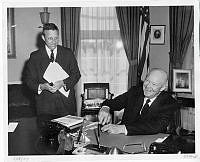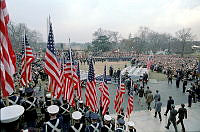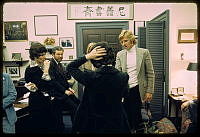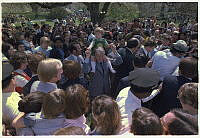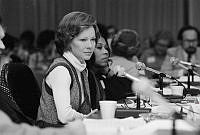Rubenstein Center Scholarship
The Life and Presidency of Warren G. Harding
The White House Christmas Ornament 2014 Historical Essay
The son of a farmer-doctor, Warren Gamaliel Harding was born in 1865 in Corsica (now Blooming Grove), Ohio. As a boy Harding worked as a printer's assistant on a local newspaper, a job that made a profound impression on him. After graduating from Ohio Central College in 1882 Harding made unsuccessful attempts to study law, teach and sell insurance before joining two partners to buy the faltering Marion, Ohio Star. With the help of state and local government-issued contracts for public printing business, the Star survived and prospered as Harding used his substantial magnetism to bring in advertising, enlarge the Star's profile, and promote the city of Marion at every opportunity.
As the Star's editor-publisher Harding had access to free railroad passes and traveled throughout Ohio, making political friendships and connections; he also polished his public speaking talents on the Chautauqua circuit, specializing in speeches acclaiming his political hero, Alexander Hamilton. Harding's geniality, charm and friendliness and his emphasis on party harmony and loyalty enabled him to adroitly make his way through Ohio's intercine Republican politics. After he was elected to the Ohio senate in 1899, journalist George MacAdam noted that Harding "had the inestimable gift of never forgetting a man's face or his name, and there was always a genuine warmth in his handshake, a real geniality in his smile. He was … a great poker player, and not at all averse to putting a foot on a brass rail."
Harding lost two bids for governor, but in 1912 his fellow Ohioan, President William H. Taft, selected him to place Taft's name in nomination for a second term at the Republican national convention – Harding's first appearance on a national stage. Two years later Harding won a seat in the United States Senate, where he compiled an unexceptional legislative record but enjoyed the camaraderie and friendship of senators on both sides of the aisle.
In December 1919 Harding entered the race for the 1920 Republican presidential nomination. His campaign manager and good friend, lawyer-lobbyist Harry Daugherty, cultivated a strategy of making no enemies and being "everybody's second choice," promoting Harding as a conciliator from a state with the fourth-highest number of electoral votes who could lead the party to victory. When a stalemate developed between better-known candidates at the republican convention in June, party leaders designated Harding for the top spot, and he was nominated on the tenth ballot. A front porch campaign followed, modeled on William McKinley's successful effort of 1896. Harding's bland but reassuring speeches and affable personality appealed to an electorate looking for surcease after the tumult and sacrifice of the war years. He won over 60 percent of the popular vote for the largest electoral victory since James Monroe's a century before.
"Our supreme task is the resumption of our onward, normal way," Harding declared in his inaugural address. He believed that the executive should cooperate with Congress as much as possible, and supported congressional moves to lower federal spending and reduce taxes on corporations, increase tariff rates, develop highways, provide expanded loans to farmers and limit immigration.
Harding favored anti-lynching legislation, preventative child health care and reduction of the work day from twelve to eight hours. In foreign affairs, the Harding administration signed official peace treaties with Germany, Austria and Hungary and made moves to improve dealings with Mexico and Latin American and Caribbean nations. It also organized efforts to reduce the number of warships and other naval armaments, and advocated U.S. membership in the Permanent Court of International Justice (World Court).
Some of Harding's executive branch appointments were of outstanding ability, while others proved sadly unworthy of the trust the president placed in them. By early 1923 a troubled Harding knew all was not well within his administration. He confessed to editor William Allen White that he was not concerned about his enemies; it was instead his friends who kept him up, walking the floor at night.
Harding's "Voyage of Understanding"
In June 1923 Harding left Washington on a scheduled two-month speaking tour largely aimed at the western United States and Alaska. The president believed his spirits would be revived by first-hand contact with natural beauty and with crowds of people while he sought support for his legislative and foreign policy goals. Harding delivered speeches, shook hands, kissed babies, and went on numerous recreational excursions, including a trip to Yellowstone National Park. However, the president spent much of his travel time restlessly pacing, playing bridge, unnerved, anxious and struggling for sleep as he agonized about the Veteran affairs corruption and oil lease scandals in his administration yet unknown to the public.
President Harding traveled in a special Pullman company observation car, the Superb. Constructed in 1911, the Superb was a 165,000-pound riveted carbon steel model of the finest in well-appointed rail travel technology of the time. It was outfitted with five bedrooms furnished with sinks and toilets, a kitchen, an observation room and a pantry, attached to compartment cars, standard sleepers, baggage cars and a dining car.
On the 470-mile leg of the train journey through Alaska in July 1923, President and Mrs. Harding and their party traveled on Alaska Railroad's Number 618 special in the Denali, an 18 year-old, 10 feet wide, 81 feet long Pullman car with a buffet, drawing and observation rooms.
On July 15, on the run from Wasilla to Willow, Harding (following a short word of instruction from engineer F.W. Brayford) climbed into the engineer's cab with Mrs. Harding, took the throttle and for the next 51 minutes drove the train 26 miles north. A reporter observed that the Hardings "had as much fun as two youngsters on their first train trip." After President Harding's death Mrs. Harding sent the white gloves he had worn while driving the locomotive to engineer Brayford as a memento.
President Harding fell ill on the return sea voyage from Alaska to San Francisco. Listless and exhausted, he died from apoplexy or stroke on the evening of August 2 in his San Francisco hotel room. What had started as a break from political scandals and a desire to communicate directly with the American people ended in a slow train ride back to Washington, D.C. with a casket on a raised bier for thousands of citizens to view and grieve the passing of a popular and beloved leader.
The Harding White House at Christmas
The Hardings enjoyed entertaining and Christmas celebrations were old fashioned with a quiet dinner and fireside gatherings with close friends. In the autumn of 1922 Mrs. Harding, afflicted by a chronic kidney ailment, drew perilously close to death. The White House cancelled all social events and the first lady's slow recovery diminished the cheer of the 1922 Christmas season. Mrs. Harding did leave her sickroom to preside over the dinner table in a wheelchair, but there was no tree and little decoration that year. President Harding enjoyed an early round of golf at the Chevy Chase Club and relaxed in the afternoon with Mrs. Harding. The president distributed a $5 gold piece to members of his staff and sent seasonal greetings to America's war veterans wishing them "a restored fortune, health and prosperity." The Hardings were also enthusiastic supporters of the Christmas Seals campaign to fight tuberculosis. A lighthearted note from the 1922 Christmas season was hunter Gabe Burkhardt of Okmulgee, Oklahoma sending the Hardings a 15-pound live white opossum fattened for the president's dinner table. The opposum's fate is not known.
FURTHER READING:
Downes, Randolph C., The Rise of Warren Gamaliel Harding, 1865-1920, Ohio State University Press, 1970
Murray, Robert K., The Harding Era: Warren G. Harding and His Administration, University of Minnesota Press, 1969
Trani, Eugene P., and David L. Wilson, The Presidency of Warren G. Harding, Regents Press of University of Kansas, 1977
Wilson, William H., Railroad in the Clouds: The Alaska Railroad in the Age of Steam, 1914-1945, Pruett Publishing Co., 1977
HISTORIC SITES:
380 Mt. Vernon Avenue
Marion, OH 43302
Phone: 1-800-600-6894
Pioneer Park / Fairbanks, Alaska








